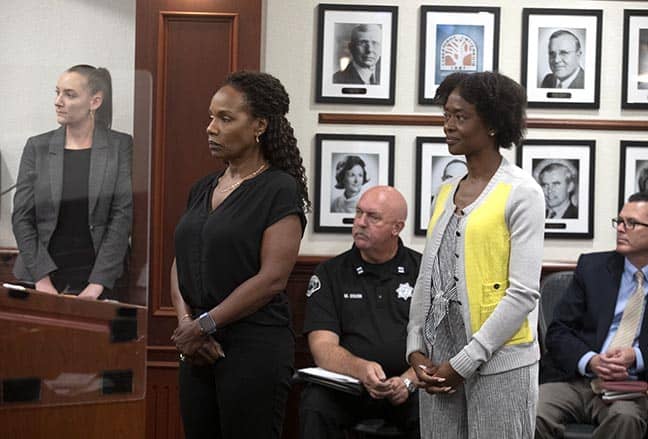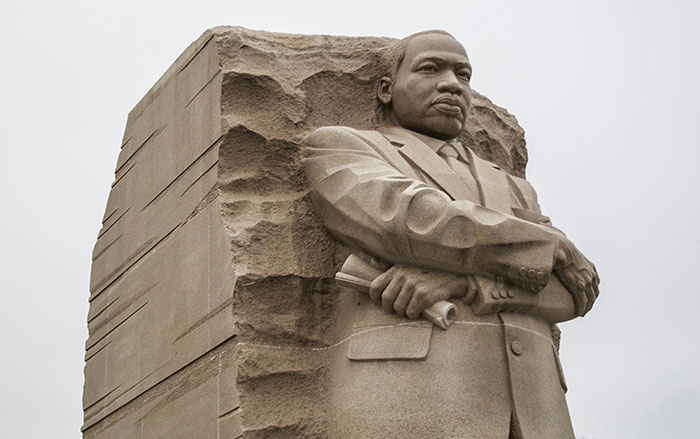Council backs committee vision of ‘reimagined’ SRO program

Members of the School Resource Officer Working Group, Lynn King-Tolliver, left, and Medina Collie listen to the comments from the Claremont City Council on Tuesday in Claremont. After some lively debate, the council voted 4-1 to approve the recommendations of the working group, that was tasked with reimagining school safety in Claremont including the future of the SRO position. seated behind are assistant to the city manager Katie Wand, police captain Mike Ciszek and police chief Aaron Fate. COURIER/photo Steven Felschundneff
by Steven Felschundneff | steven@claremont-courier.com
On Tuesday the Claremont City Council gave its seal of approval to a committee’s vision for reforming safety at Claremont’s public schools. However, it’s likely the council will have to consider the issue again before any changes go into effect.
By a 4-1 vote, the council agreed with the recommendations of the School Resource Officer Working Group, which had been given the task of “reimagining” the on-campus safety program, including the future of the school resource officer position.
The working group was impaneled last year by then Mayor Jennifer Stark after the council voted to end the current SRO program. The group created the proposed framework during a series of meetings held February through August, going through several versions before finalizing the one presented to the council on Tuesday.
The panel’s recommendation fell short of eliminating the school resource officer position, but favored refocusing the officer’s duties, including how and where that person would interact with students.
“The reimagining of the SRO in Claremont schools stresses the ‘resource’ component rather than the ‘officer,’ component, limiting the physical presence of the SRO in day-to-day campus security operations and eliminating the SRO’s involvement in student discipline matters, unless it involves criminal activity,” according to a staff report.
The SRO is a uniformed and armed police officer who is specifically assigned to patrol Claremont’s 10 public school campuses. The $170,000 program is paid for equally by the City of Claremont and Claremont Unified School District. Because of the hybrid funding, any action by the council affecting the SRO position must be approved by the CUSD Board of Education.
In July 2021 the council approved a resolution that, effective June 30, 2022, the city would “re-designate the school resource officer to a lateral designation within the police department with a secondary assignment to the Claremont Unified School District provided that funding is available to ensure no loss of coverage, staff or police officer positions.”
Although that June deadline came and went without any changes to the program, the working group continued with the task at hand, resulting in the framework presented Tuesday.
Many Claremont residents, including parents of school age children, have campaigned for changes to on-campus policing, which they say disproportionally targets Black and Hispanic students and is not effective in making schools safer. Conversely, some parents have said during public comment that the presence of a police officer on campus makes them feel like their children are protected, particularly with the growing national frequency of on-campus shootings.
On Tuesday the council was asked to decide between “Framework A” which was the verbatim recommendation of the SRO Working Group, and “Framework B,” which “contains staff-recommended modifications, based on our discussions with Claremont Unified School District administration,” according to the city staff report. The council also needed to approve a memorandum of understanding with the school district to keep the program going.
The working group suggested that the school resource officer, Brittany Sornborger, focus her patrols on the perimeter of Claremont campuses, “to be aware of suspicious activity that may be occurring near schools.” She would be present on school campuses when requested by CUSD officials for emergencies or calls for service. She would also be present for security at large events such as assemblies and Claremont High School graduation.
The district wants to ensure the SRO continues to have a presence on campus, so that the officer is familiar with staff, knows the bell schedule, is familiar with how to access each campus and most importantly, would be familiar with the students.
“CUSD staff has asked that the city council consider removing the language from the SRO framework that would not allow the SRO to regularly be on school campuses, with the understanding that this does not mean that the SRO will begin patrolling campuses for students who are breaking rules,” according to a presentation by Katie Wand, assistant to the city manager.
Reached by phone on Wednesday, Brad Cuff, CUSD assistant superintendent, student services, said the changes to the working group’s framework were made after consulting with staff and reflected the district’s desire to provide input. He characterized the alterations as “clarifications,” many of which were his recommendations. He said some of the language was removed due to redundancy between the memorandum of understanding and the framework.
The district has also requested that concepts be removed from the SRO framework that wholly pertain to the CUSD Board of Education.
An example of language removed by the district includes the following excerpt found under the heading of “Goals for the SRO Program”:
“The SRO Working Group would like to suggest that in addition to CUSD’s current resources, additional resources guided by best practices and an equity lens should be identified and allocated to address mental health needs.”
Asked for clarification on why this language was targeted for removal, Cuff said, “We have robust mental health services and felt that was not in the council’s purview to be putting that in the recommendations.”
He added that the district consistently addresses matters through an equity lens.
During council debate the discussion seemed to be leaning toward an “Option C” wherein the city and the district would form a panel to hammer out the differences between the two frameworks.
“Do you think there is a way to get to yes without having to pick either choice A or choice B, but a path that would lead to further collaboration to firm up some of the language?” councilmember Jennifer Stark asked CUSD Superintendant Jim Elsasser.
“We would be happy to come together with representatives from the city to explore adjustments in the framework to really meet the needs of both the city and the district,” Elsasser said. “Our interest would be to create a working group just like the old six pack where have council members and two board members, city manager and superintendent come together with the draft from the advisory group and let us have a conversation and a common understanding and make some revision based on the input we have received from the respective community groups.”
Mayor Jed Leano seemed to agree, commenting that from his reading the two groups were not that far apart.
Following public comment and continued deliberations, Stark suggested the council vote on approving “Framework A,” as part of the process of identifying the council’s wishes. The 4-1 yes vote effectively ended, for the time being, the discussion of forming another panel.
The lone no vote was cast by Mayor Pro Tem Ed Reece who wanted the council to retain the ability to negotiate with the district.
“I believe CUSD will want to negotiate changes to our proposed MOU. As such, it was important to me to impanel a negotiating group immediately, that includes two working group representatives, to finalize the agreement most expeditiously. Including the work group representatives allows their intent, goals, and participation to directly influence the final signed agreement,” Reece said.
As the chamber emptied, Elsasser told the COURIER that given the council’s decision he will most likely have to bring both frameworks A and B to the CUSD Board of Education for its review.








0 Comments